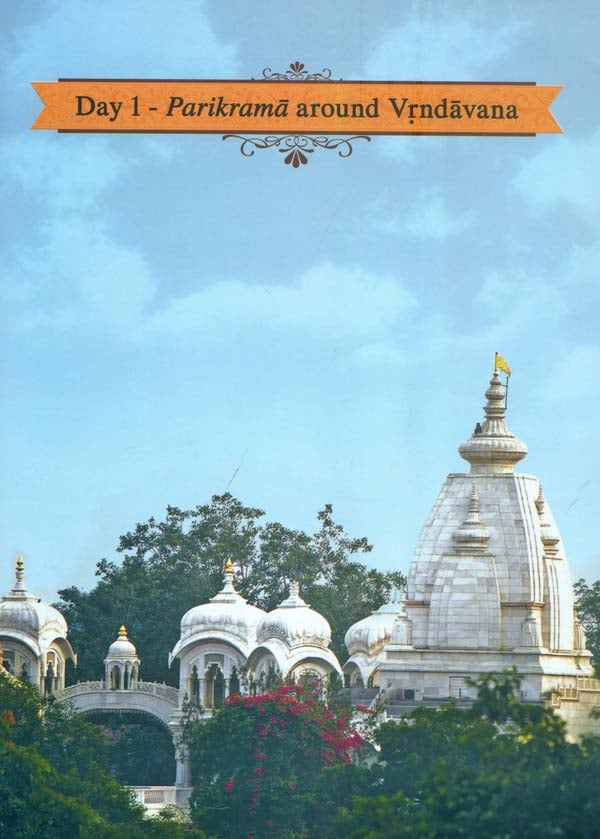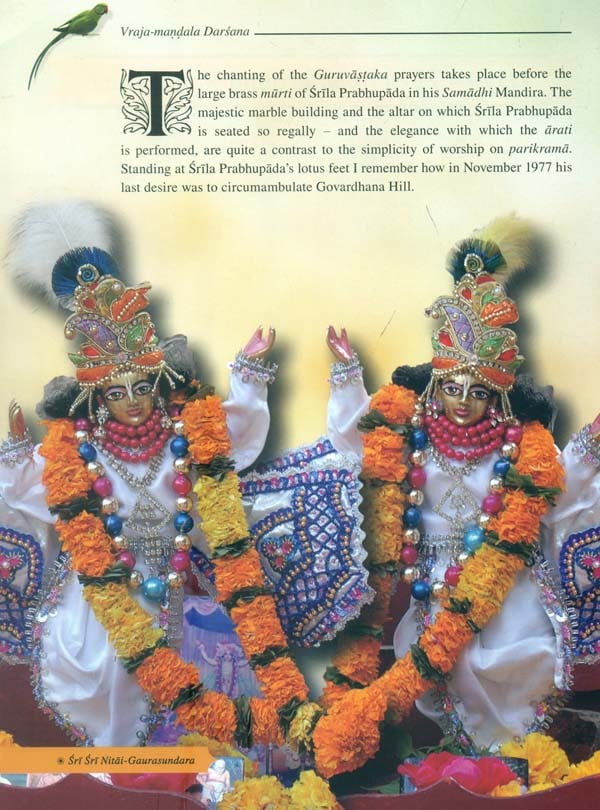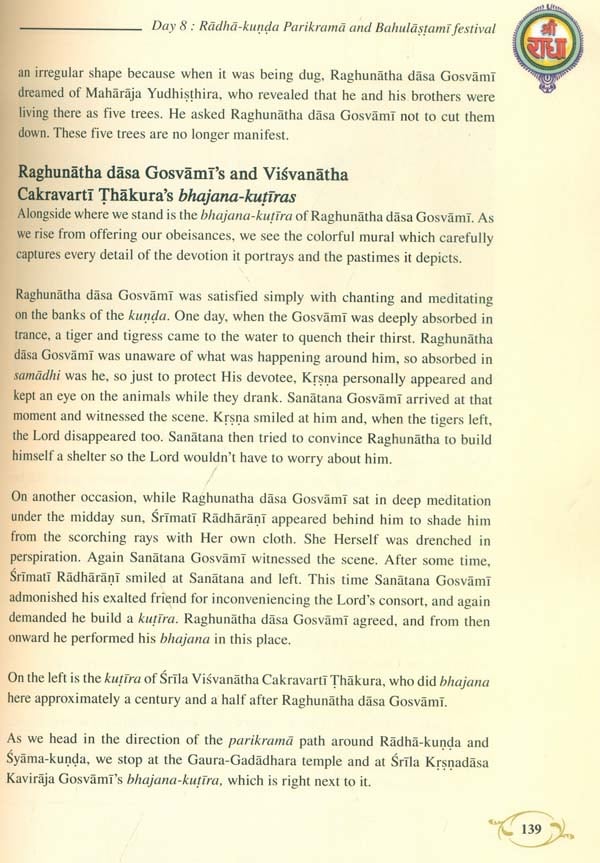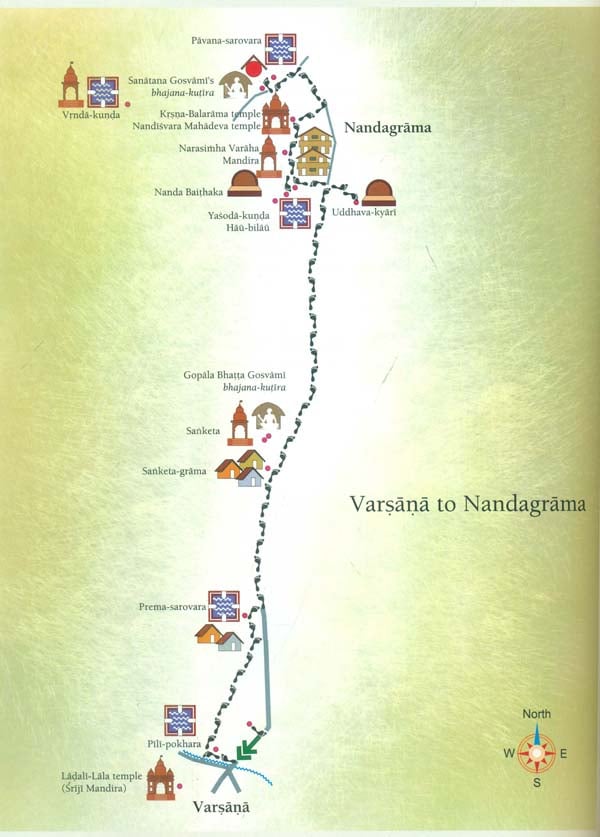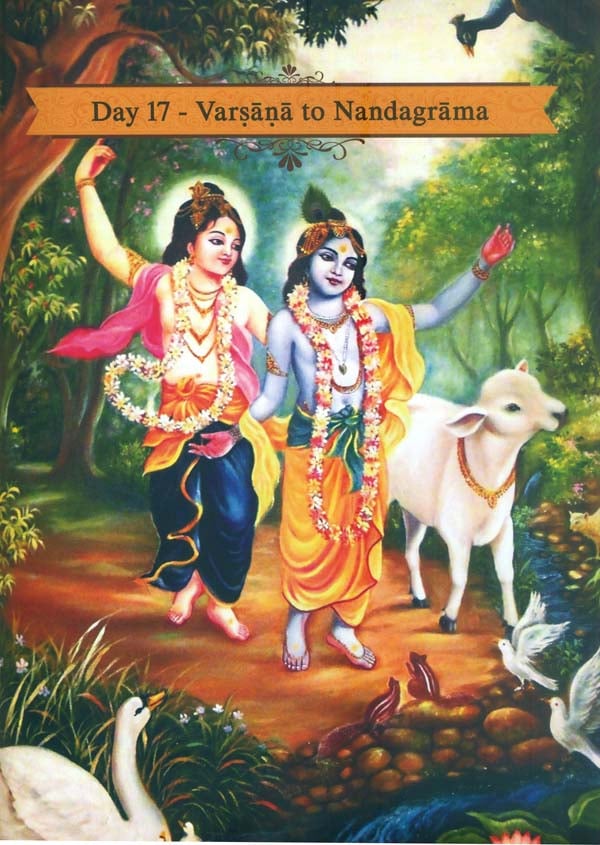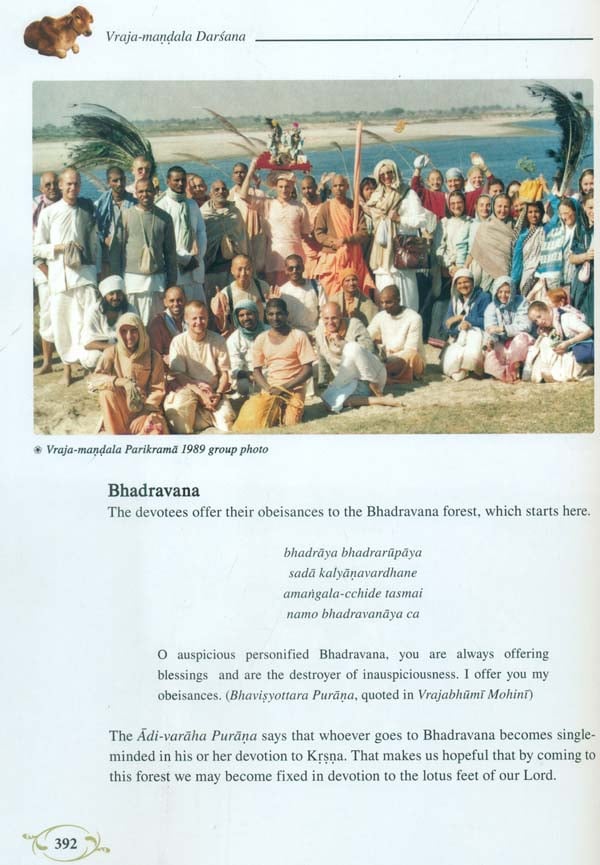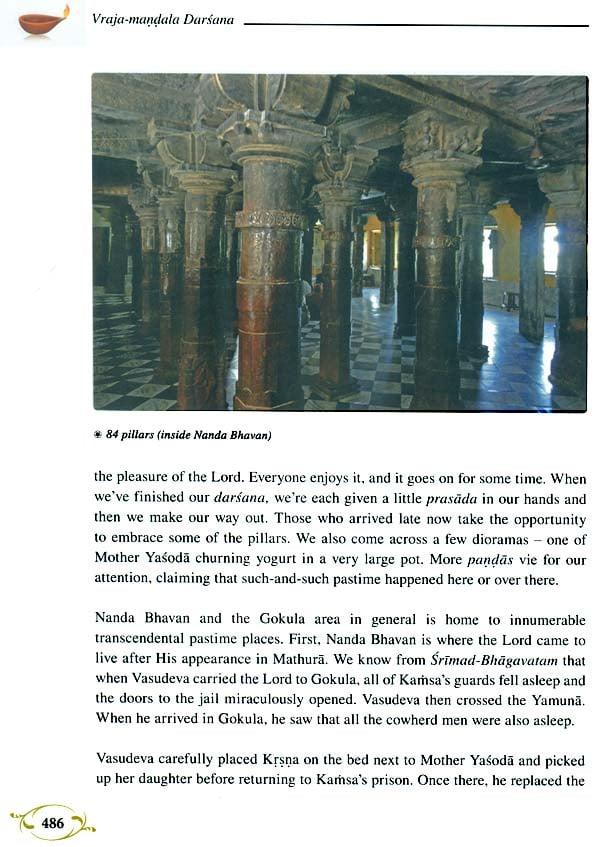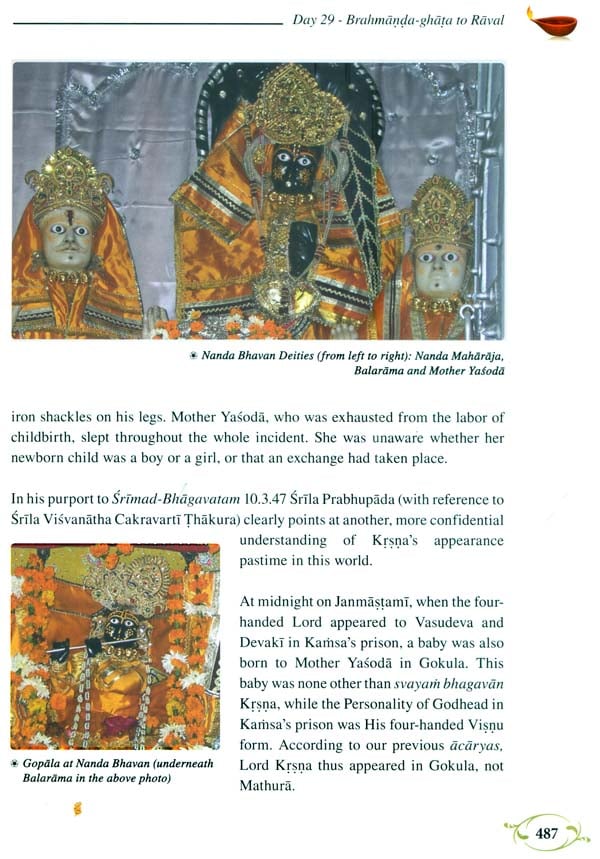
Vraja Mandala Darsana - A 30 Day Parikrama Experience
Book Specification
| Item Code: | NAO566 |
| Author: | Lokanath Swami |
| Publisher: | Padayatra Press, Noida |
| Language: | English |
| Edition: | 2015 |
| ISBN: | 9788193563557 |
| Pages: | 605 (Throughout Color Illustrations) |
| Cover: | Hardcover |
| Other Details | 9.5 inch X 7.5 inch |
| Weight | 1.50 kg |
Book Description
My first experience with parikrama was on my first visit to India in 1976. In both Mayapur and Vrndavana, after Srila Prabhupada's lecture and breakfast, we would visit the pastime places of Lord Caitanya and Lord Krsna. It was a mixed experience: I had not yet adjusted to India either physically or mentally, and the sheer number of devotees on parikrama made it difficult to hear, what to speak of fully appreciate the intimate spiritual atmosphere. In truth such parikramas left me a little dazed.
As years passed, I became suitably acclimated to India, and my taste for parikrama grew, as did my attachment to the dhamas and to Lords Gauranga and Krsna, Thus, aside from associating with senior Vaisnavas, my main interest in visiting Mayapur and Vraja was to immerse myself in the Lord's pastimes, and that immersion opened a new vista of Krsna consciousness for me.
And yet, once I boarded the plane and left the dhama behind, as time passed I would find my enhanced Krsna consciousness gradually fading. I couldn't live in Vrndavana, but I realized that I couldn't progress in Krsna consciousness without doing so.
Then one day I came across the following verse:
krsnam smaran janam casya
prestham nija-samihitam
tat-tat-katha-ratas casau
kuryad vasam vraje sada
The devotee should always think of Krsna within himself and should choose a very dear devotee who is a servitor of Krsna in Vrndavana. One should constantly engage in topics about that servitor and his loving relationship with Krsna, and one should live in Vrndavana, If one is physically unable to go to Vrndavana, he should mentally live there. (Caitonya-caruamrta, Madhya 22.161)
"Live in Vrndavana mentally."
With that simple instruction, Srila Prabhupada answered my quest to perform parikrama continually. It was immaterial whether my body was in the USA or the UK. If my mind was absorbed in the Lord's dhamas and lilas, I could be in Vraja and be with Krsna.
To nurture remembrance of Vrndavana, I began to read the parikrama books available at the time - such as those by Padmalochan Prabhu - as well as books by our acaryas, like Vraja-vildsa-stava. Just as I chanted japa when I visited pastime places in India, I could now visit pastime places while chanting japa in the West.
For me, therefore, Lokanath Maharaja's Vraja-mandala Darsana is not only a guide through Vrndavana but a means to live in Vraja while I serve in Hungary. I am indebted to him for giving me further inspiration for my Krsna consciousness, and I urge the readers of his book to use it not solely as a guide through Vraja, but as a guide through life back to Krsna.
Lokanath Maharaja has narrated Krsna's pastimes In his simple yet erudite style so we may learn to live with Krsna and thus be insulated from the Lord's external potency. In this way, our dormant attachment for Vraja and its residents will gradually awaken in our hearts and, as the quotation I gave says, we will naturally become attracted to certain pastimes, places, and Vrajavasis. Such attachment will eventually open for us the door to eternal Vraja, where we can one day be part of the pastimes other practicing devotees will be hearing about and remembering here on earth. No doubt, even after the author of this book has entered into Krsna's eternal lila as the servant of a Vrajavasi, his book will continue to guide others to that same divine destination.
Introduction The word parikrama means "to circumambulate." There are different types of parikrama - one can circumambulate the Deity or the sacred tulasi plant, for example, or one can walk around the holy dhamas, kU1J9-as, and samadhis. Parikrama allows us to offer our respect to and honor the object we are circumambulating. Parikrama is listed as one of the sixty-four items of devotional service mentioned in the sixth chapter of The Nectar of Devotion:
One must circumambulate the temple building at least three times. (In every temple there is an arrangement to go around the temple at least three times. Some devotees go around more than three times - ten times, fifteen times - according to their vows. The Gosvamis used to circumambulate Govardhana Hill). One should also circumambulate the whole Vrndavana area.
Of parikramas to the various dhamas around India, the ultimate parikrama is of Vraja-mandala, also referred to as caurasi-krosa parikrama. Caurasi means "eighty-four" and one krosa equals about two miles, so the total parikrama is 168 miles long. ISKCON's Vraja-rnandala parikramas are a little longer - this figure does not include the additional distance covered during the localized parikramas we perform at certain junctures, such as the Mathura parikrama, the Govardhana parikrama, the Kamyavana parikrama, and so on.
How Vraja-mandala parikrama started in ISKCON
Our yearly Vraja-mandala parikrama program is the natural extension of an instruction Srila Prabhupada gave me in 1976. In the early part of that year, I was serving with the Nitai-Gaura World Traveling Sankirtana party, which was traveling in two German buses and preaching in North India. Our program had been successful for several months, but unfortunately, because of problems with India's Vehicle Controls Department, the buses had to leave India.
Around Radhastami that year, our party heard that Srila Prabhupada was in Delhi, so we decided to report to him the loss of our buses and ask for instructions. When I met with him, Srila Prabhupada told me to forget about the buses and instead start a bullock-cart sankirtana party. He suggested I travel and preach in the villages of India.
Srila Prabhupada reiterated his instruction in subsequent meetings in Delhi and Vrndavana, and he gave me detailed instructions on how to bring harinama and book distribution to the villages. This led to the birth of ISKCON's padaydtrd program. Not long afterwards, we left with our first bullock cart from Vrndavana to Bengal, Odisha, and up to Bhubaneshwar. Then, due to unavoidable circumstances, there was a break in the program.
ISKCON Padayatra had its renaissance in 1984 when Jayapataka Swami proposed the idea of doing a padayatra that retraced Sri Caitanya Mahaprabhu's footsteps in honor of the 500th anniversary of Lord Caitanya's appearance. Soon, the proposal was made before the GBC and was passed unanimously, with ISKCON leaders supporting the endeavour with tremendous enthusiasm.
On September 2, 1984 the padayatris assembled in Dvaraka and began their walk to Mayapur via Kanyakumari, the southernmost tip of India. The trip took nineteen months. The party arrived in Sridhama Mayapur on March 20, 1986, just in time for Lord Caitanya's 500th Gaura Purnima. It was a historic walk - a nearly impossible dream come true.
The padayatra program was meant to end in Mayapur that Gaura Purnima, but we had met with such huge success that we could do nothing but carryon! After the Gaura Purnirna celebrations, we decided to complete the parikrama circle by returning to Dvaraka.
Our new itinerary would take us north to Badarikasrama, which was the only dhama of the four the padayatra had yet to visit. (We had visited the other three - Dvaraka, Ramesvaram, and Jagannatha Purl - on our way to Mayapur). Vrndavana was more or less on the route to Badarikasrama, so we decided we would also stop there. ISKCON Padayatra arrived in Vrndavana just before the 1987 Mayapur- Vrndavana festival. In those days we held a yearly Vrndavana festival right after the Gaura Purnima festival in Mayapur. Although we came to Vrndavana for the festival and to visit our Krishna-Balaram temple before continuing on to Badarikasrama, the Lord had other plans for us.
My godbrother, Dhruva Maharaja Prabhu, had gone all around Vraja and taken photographs, from which he had put together a slideshow about the twelve forests of Vraja. The padayatra devotees watched this enchanting slideshow, and it occurred to us that we too could circumambulate Vrndavana's twelve forests. After all, we were walkers, so why not circumambulate Vraja? Up until that point - and like most ISKCON devotees - we were only familiar with two parikramas: the one around the town of Vrndavana (paaca-krosa and Govardhana parikrama. Now we found ourselves wondering what lay beyond those beaten tracks! We set out to find out, touring the land of Sri Krsna and establishing ISKCON's first ever Vraja-rnandala parikrama. This was March 1987, close to the Vrndavana festival of that year. It was convenient for devotees to join us as they streamed into Vraja from Mayapur, Dhruva Maharaja Prabhu accompanied us on that first walk, kindly offering to guide us as he was familiar with the route. In 1988 we decided to do the Vraja-rnandala parikrama during Karttika.
The inspiration for Vraja-mandala Darsana
The idea to compile a book about Vraja-rnandala parikrama emerged when the parikrama devotees began asking that we make available in written form the pastime narrations we offer on parikrama. Someone even suggested this book could become a guidebook for pilgrims.
In the early days of the parikrama I gave most of the talks. One year we recorded and later transcribed all of them. But as I began to meditate, with my team, on what we should offer, it became clear to us that we didn't want to create just another guidebook. We wanted our book to be something more than that; we wanted to talk about the experience of life on parikrama.
| Mangalacarana | vii |
| Foreword | xii |
| Introduction | xiv |
| The Glories of Vraja | xiv |
| Acknowledgments | xxviii |
| Day One: Parikrama Around Vrndavana | 1 |
| Day Two: Vrndavana to Mathura | 27 |
| Day Three: Mathura Parikrama | 43 |
| Day Four: Mathura to Madhuvana | 61 |
| Day Five: Madhuvana to Santanu-kunda | 75 |
| Day Six: Santanu-kunda to Radha-kunda | 87 |
| Day Seven: Govardhana Parikrama | 103 |
| Day Eight: Radha-kunda Parikrama and Bahulastami festival | 131 |
| Day Nine: Radha-kunda to Dig | 155 |
| Day Ten: Dig to Badarinatha | 165 |
| Day Eleven: Badarinatha Parikrama | 177 |
| Day Twelve: Badarinatha to Kamyavana via Kedarnatha | 189 |
| Day Thirteen: Kamyavana Interior Parikrama | 201 |
| Day Fourteen: Karnyavana Exterior Parikrama | 219 |
| Day Fifteen: Kamyavana to Varsana | 231 |
| Day Sixteen: Govardhana-puja and Varsana Parikrama | 245 |
| Day Seventeen: Varsana to Nandagrama | 271 |
| Day Eighteen: Srila Prabhupada's Disappearance Day & Visiting Khadiravana | 297 |
| Day Nineteen: Nandagrama to Kokilavana | 319 |
| Day Twenty: Kokilavana to Sesasayi | 343 |
| Day Twenty-one: Sesasayi to Shergarh | 357 |
| Day Twenty-two: Shergarh to Cira-ghata | 367 |
| Day Twenty-three: Cira-ghata to Mat | 385 |
| Day Twenty-four: Mar to Mana-sarovara | 411 |
| Day Twenty-five: Mana-sarovara to Lohavana | 423 |
| Day Twenty-six: Lohavana to Dauji., | 435 |
| Day Twenty-seven: Daaji to Brahmanda-ghata | 447 |
| Day Twenty-eight: Brahmanda-ghata (and sharing realizations) | 463 |
| Day Twenty-nine: Brahmanda-ghata to Raval., | 479 |
| Day Thirty: Raval to Vrndavana via Mathura | 509 |
| Appendix | 524 |
| Eight kunjas surrounding Radha-kunda | 524 |
| Demons in Lord Krsna's pastimes and the anarthas they represent | 526 |
| Lord Krsna's lotus feet. | 530 |
| SrlmatI Radharani's lotus feet... | 531 |
| Vaisnava bhajanas | 532 |
| References | 536 |
| General Index | 540 |
| Index of Verses | 574 |
